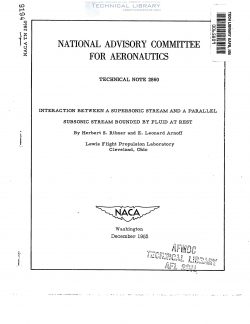naca-tn-2860
- Version
- 111 Downloads
- 1.30 MB File Size
- 1 File Count
- January 17, 2017 Create Date
- January 17, 2017 Last Updated
National Advisory Committee for Aeronautics, Technical Notes - Interaction Between a Supersonic Stream and a Parallel Subsonic Stream Bounded by Fluid at Rest

In a simplified inviscid model of shock-wave boundary-layer inter-
action, Tsien and Finston have replaced the boundary layer by a uniform
subsonic stream bounded on one side by a solid wall and on the other
side by the interface with a uniform supersonic stream of semi- infinite
extent. Among other things, this model fails to simulate the separated
region or "dead- air" bubble that generally appears in a laminar boundary
layer subjected to an Oblique incident shock wave of moderate strength.
In order to introduce a main feature of such a dead-air region, the model
has been modified herein by replacing the solid wall by an interface with
fluid at rest.
The presence of the boundary layer sandwiched between the outer
supersonic flow‘and the dead-air regibnis found scarcely'to modify the
shape, in the vicinity of the shock, of the expansive "corner" turn that
would exist if”the shock were incident directly on the dead-air region
without the intermediary of the boundary layer; there are local distor-
tions top and bottom, but these are reduced to negligible amounts several
boundary-layer thicknesses to the left or right of the effective corner.
In support of a phaSe of the work of Lester Lees, it is concluded
that in a more accurate treatment of the complete region of shock
boundary-layer interaction the Prandtl boundary-layer equations may be
applied to the entire extent of the disturbed boundary layer, applying
as a boundary condition a sudden turn of the displacement surface through
twice the shock deflection angle at the point of shock incidence. There-
by the flow details in the immediate vicinity of the shock will be some-
what in error, but the over-all features of the interaction are capable
of being given correctly. Present unknown elements in such an application
appear to be the point of transition from laminar to turbulent flow and
the form of the turbulent equations where a separated bubble exists.
The complex problem of the interaction between shock waves and
boundary layers in supersonic flow is not yet clearly understood,
despite a number of theoretical studies (references 1 to 7). Among
these, the analysis of Tsien and Finston (reference 2) is singled
out here for further examination. In the Tsien-Finston model the
boundary layer is simulated by a iform subsonic stream of finite
width bounded on one side by a s id wall and on the other side by
the interface with a uniform supersonic stream of semi—infinite
extent. The fluid is assumed to be nonviscous and nonheat-conducting
and the disturbances are assumed small.
| File | Action |
|---|---|
| naca-tn-2860 Interaction Between a Supersonic Stream and a Parallel Subsonic Stream Bounded by Fluid at Rest.pdf | Download |

Comment On This Post